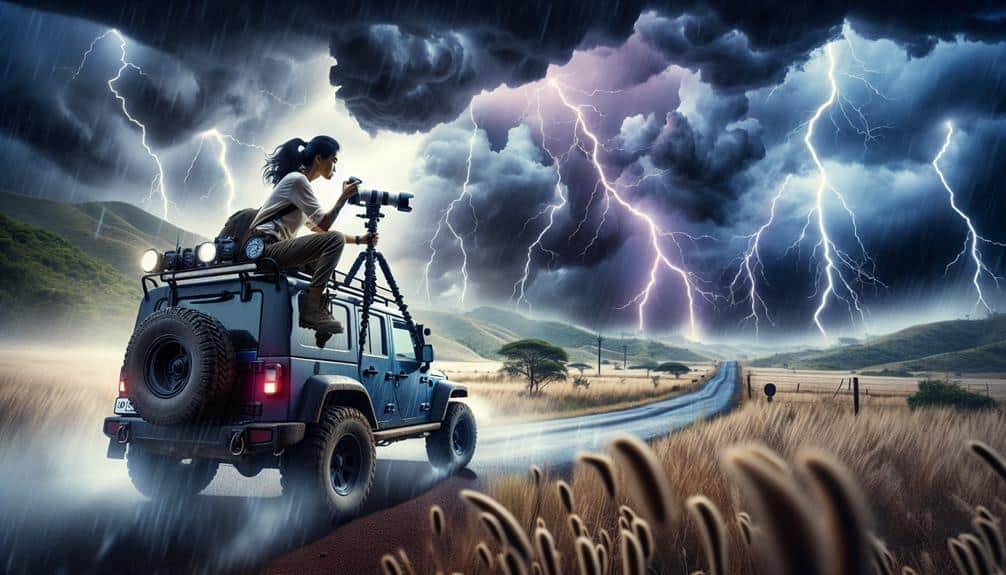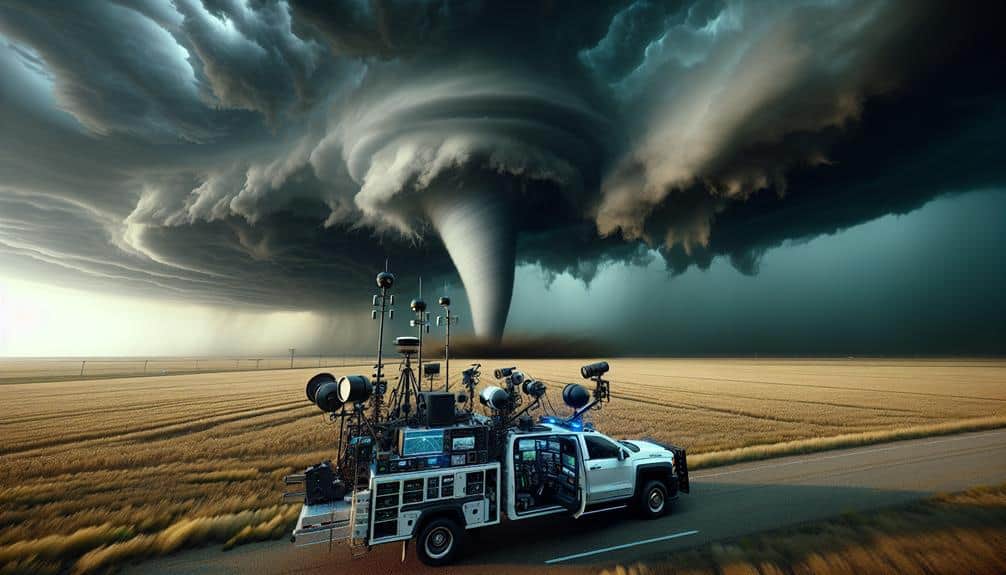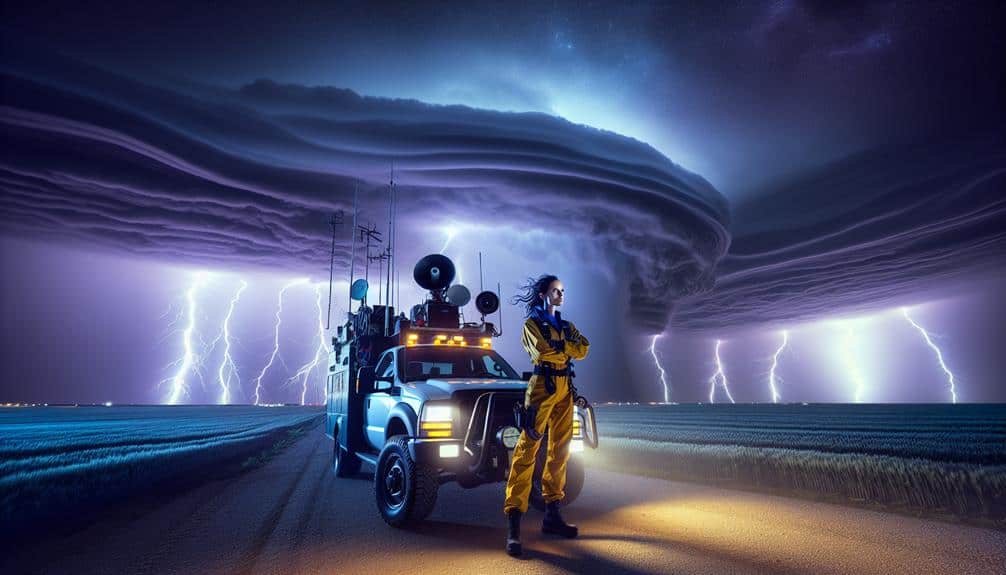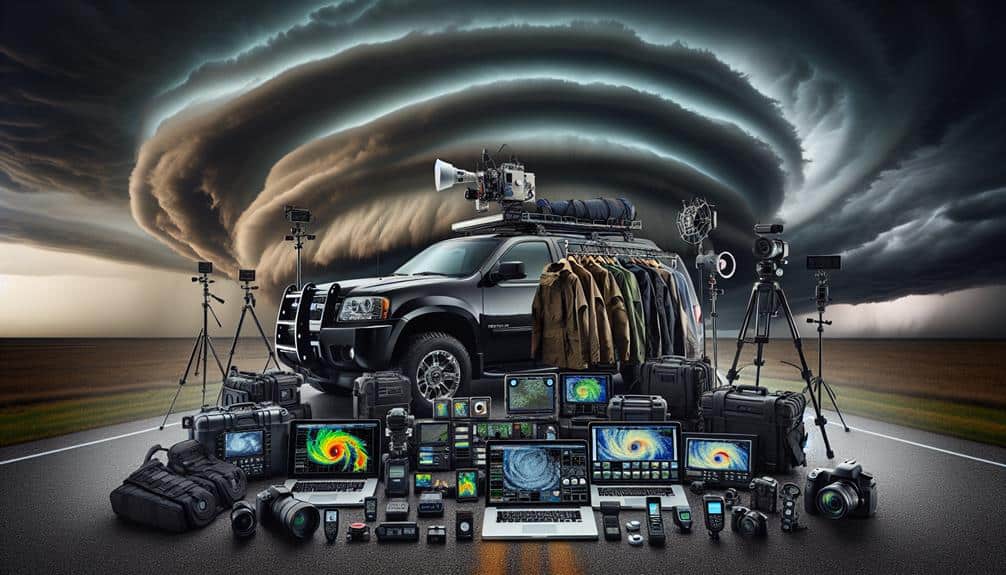For storm chasing hobbyists, we should start by thoroughly researching weather patterns using tools like Doppler radar and numerical weather models, focusing on temperature gradients, humidity, and wind shear. It's crucial we prioritize safety gear, including high-visibility clothing and durable helmets. Joining a storm chasing group can enhance our knowledge through collective data analysis and structured learning. Mastering navigation skills by integrating map reading with GPS technology enhances our situational awareness. Finally, investing in high-quality equipment, from advanced cameras to robust GPS units, ensures our chases are efficient and productive. Discover more ways to maximize our storm chasing adventures.
Key Points
- Prioritize Safety Gear: Always wear high-visibility clothing, a durable helmet, and carry a well-stocked first aid kit and emergency supplies.
- Research Weather Patterns: Utilize Doppler radar, satellite imagery, and real-time data from the National Weather Service for accurate storm prediction.
- Join a Storm Chasing Group: Gain access to collective knowledge, advanced equipment, and participate in training programs for skill enhancement.
- Master Navigation Skills: Hone map reading skills and use GPS tracking technology for real-time monitoring and precise storm targeting.
Research Weather Patterns
Understanding and analyzing weather patterns is vital for accurately predicting storm activity and ensuring a safe storm chasing experience. We need to hone our skills in weather tracking to anticipate storm behavior effectively. By utilizing advanced meteorological tools such as Doppler radar, satellite imagery, and numerical weather prediction models, we can gather crucial data on atmospheric conditions.
Our storm prediction efforts should focus on identifying key indicators such as temperature gradients, humidity levels, and wind shear. These elements contribute to the formation and intensity of storms. For instance, a sudden drop in atmospheric pressure often signals the development of severe weather.
Accessing real-time data is essential. Websites like the National Weather Service (NWS) and mobile apps can provide up-to-the-minute updates. We should also familiarize ourselves with storm structure and dynamics, including supercell thunderstorms and tornado genesis. This knowledge allows us to make informed decisions on when and where to chase, maximizing both safety and the potential for capturing impressive storm footage.
Our commitment to continuous learning and data analysis keeps us prepared for the unpredictable nature of storm chasing. By mastering weather tracking and storm prediction, we can embrace the freedom of the chase with confidence and precision.
Prioritize Safety Gear
Equipping ourselves with necessary safety gear is crucial to reduce risks and guarantee our well-being during storm chasing expeditions.
Thorough emergency preparedness begins with a detailed risk assessment of potential hazards we may encounter. Let's prioritize high-visibility clothing to make sure we're seen by other motorists, especially in low-visibility conditions. A durable helmet is essential to shield us from flying debris, a common risk during severe storms.
In addition, we must carry a well-stocked first aid kit, including items like antiseptics, bandages, and pain relievers. Making sure our vehicle is equipped with emergency supplies, such as flashlights, batteries, and a multi-tool, enhances our ability to address unforeseen situations promptly. Communication is crucial, so we should invest in a reliable two-way radio and a fully charged power bank for our mobile devices.
From an analytical standpoint, data indicates that most storm-chasing accidents result from inadequate preparation and insufficient gear. By integrating thorough safety equipment, we significantly reduce our exposure to danger.
Furthermore, documenting and reviewing our gear effectiveness after each chase will refine our risk assessment process for future expeditions. In the pursuit of freedom, prioritizing safety gear guarantees we can chase storms without compromising our well-being.
Join a Storm Chasing Group
Joining a storm chasing group enhances our experience by providing access to collective knowledge, advanced equipment, and real-time data analysis. These groups are built on strong group dynamics and effective networking, which are vital for a successful storm chase. By leveraging the expertise of seasoned chasers, we gain insights that would take years to acquire on our own. Additionally, the pooling of resources allows us access to high-end meteorological tools and vehicles equipped with the latest technology, significantly increasing our chances of capturing essential data.
Training programs offered by these groups are invaluable. They provide structured learning environments where we can hone our skills, from understanding weather patterns to using specialized equipment. Experience sharing within the group fosters a culture of continuous learning and improvement. Data from each chase is meticulously analyzed, and lessons learned are disseminated among members, ensuring that we're constantly refining our techniques.
Moreover, the camaraderie and support found in these networks offer both motivation and safety. Knowing that we're part of a community dedicated to the same passion not only enhances our individual capabilities but also provides a robust support system. Joining a storm chasing group is necessary for anyone serious about this thrilling pursuit.
Proficiency in navigation is vital for storm chasers, as it directly impacts our ability to safely and efficiently track severe weather phenomena. Mastering both map reading and GPS tracking is pivotal to guarantee we can adapt to rapidly changing conditions.
Let's break down the key skills we need to hone.
First, map reading is foundational. Understanding topographical maps allows us to analyze terrain, identify safe routes, and locate potential obstacles. We should practice interpreting various map scales and symbols to make quick, informed decisions. A strong grasp of cartography not only enhances our situational awareness but also provides a reliable backup when technology fails.
Next, GPS tracking technology is indispensable in modern storm chasing. Utilizing advanced GPS systems, we can monitor our position in real time, calculate travel times, and find optimum paths to intercept storms. Integration of GPS data with weather radar apps allows for precise targeting of severe weather cells. Familiarity with different GPS units and their functionalities can greatly enhance our navigation efficiency.
Combining traditional map reading with cutting-edge GPS tracking equips us with a versatile navigation toolkit. This dual approach maximizes our ability to pursue storms with both freedom and safety, ensuring we can navigate any scenario that comes our way.
Invest in Quality Equipment

Investing in high-quality equipment is necessary for guaranteeing we capture accurate data and maintain safety during storm chasing missions. When it comes to camera selection, opting for a DSLR or mirrorless camera with a high frame rate and low-light capabilities will greatly enhance our ability to document storm conditions. A reliable, high-resolution camera guarantees we gather clear, actionable data.
GPS tracking is another non-negotiable. Advanced GPS units provide real-time positioning, allowing us to navigate complex weather systems with precision. This technology is crucial for avoiding hazardous areas and optimizing our chase route.
Vehicle maintenance can't be overlooked. Regular inspections and servicing of our chase vehicle ensure it performs reliably under extreme conditions. Essential checks include tire integrity, fluid levels, and battery health. A well-maintained vehicle is our frontline defense against the unpredictable nature of storms.
Communication devices are equally essential. Investing in robust two-way radios and satellite phones ensures we maintain constant contact with team members and emergency services, even when cellular networks fail. High-quality communication devices are indispensable for coordinating movements and sharing real-time updates.
Frequently Asked Questions
How Do I Choose the Best Time of Year for Storm Chasing?
Selecting the finest time for storm chasing is like maneuvering through a intricate maze. We analyze weather patterns and forecast accuracy, assess risks, and prioritize safety precautions. Ideal periods vary, but late spring often offers peak conditions.
What Should I Include in My Storm Chasing Emergency Kit?
For our storm chasing emergency kit, we should include emergency essentials like a first aid kit, water, non-perishable food, and tools. Safety precautions are vital; always carry a weather radio, maps, flashlights, and extra batteries for preparedness.
Are There Specific Apps That Can Enhance My Storm Chasing Experience?
Of course, we need top weather apps to “enhance” our storm chasing experience. RadarScope offers detailed data, while Storm Shield focuses on safety precautions. Let's embrace the thrill of freedom with calculated risks and precise information.
How Can I Ethically Document Storms Without Causing Harm?
To ethically document storms, we must prioritize storm safety and consider the environmental impact. Using ethical photography practices, we avoid causing harm while capturing storm documentation. It's important to respect nature and local communities during our pursuits.
What Are Some Common Mistakes to Avoid While Storm Chasing?
Remember when we rushed without proper planning and ignored safety precautions? We almost got trapped. Always prioritize safety and meticulously plan routes. Data-driven decisions guarantee we chase storms effectively while minimizing risks. Let's chase wisely and freely.


